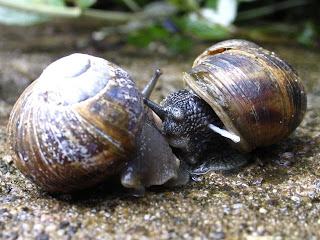A female Nomada cuckoo bee
Something that never fails to surprise me, is that once I have a name to some beast or plant, I start to come across it more often: Learning allows you to see. This happened to me recently with
Nomada bees. Before I had an ID I thought they were some sort of wasp. I had seen them often in my front garden. A few days ago I came across three of them, loitering around a crack in the pavement on a south facing garden in my street and got a few shots. Why wouldn't I identify them as wasps? They are almost hairless, slender, with a thin wasp-like waist and neat black and yellow striped abdomens. Again
Wild About Britain, my favourite wildlife forum, proved me wrong. The wasps were in fact, cuckoo bees of the genus
Nomada. This is a very large genus, worldwide over 800 species (around 30 British sp.) which mainly cleptoparasitise bees of the genus
Andrena, particular
Nomada species tend to be host-specific, that is, they specialize in parasitizing a single
Andrena species. Note I wrote 'cleptoparasites', what means is that they actually lay their eggs in nests of bee species, on the pollen supply intended for the developent of the bee larva.
Nomada males and females are often found around their host nests. Males waiting for females to emerge and then mate with them. The females lay their eggs in cells being provisioned by the host. Their larva kills the host larva and eats the pollen provision during its development.
Research into
Nomada chemical communication has revealed a complex, puzzling system in which some of the hosts chemicals are also produced by the parasite.
Nomada males produce chemicals identical in composition to secretions of the female
Andrena species they parasitize which they use to line their nest cells. Why is the male and not the female which produces this chemicals is not know. It could be that upon copulation the male parasite transfers the secretion to the female and thus she can enter the nests with a chemical 'camouflage'? Is this to show the female the right species' nest? Both explanations seem feeble, as it would seem simpler that both sexes would learn the odor of the nests they grew in, and that females could in theory produce the smell themselves if that renders them less likely to be attacked in the host's nest.
The particular Nomada species in our front garden seems to be
N. marshamella, which parasitises several species of
Andrena (
A. carantonica,
A. scotica,
A. trimmerana,
A. nigroaena). Some of these nest communally in hole or cracks in pavements. So, all this fascinating chemical communication and tales of robbery and killing might be happening, literally, just outside your front door.
Two Nomada bees waiting at the entrance of an Andrena nest.
This one is about to enter the nest
Andrena bee resting (possibly A. carantonica). This genus is not only parasitized from Nomada cuckoo bees, but males are also deceived by orchids!





























